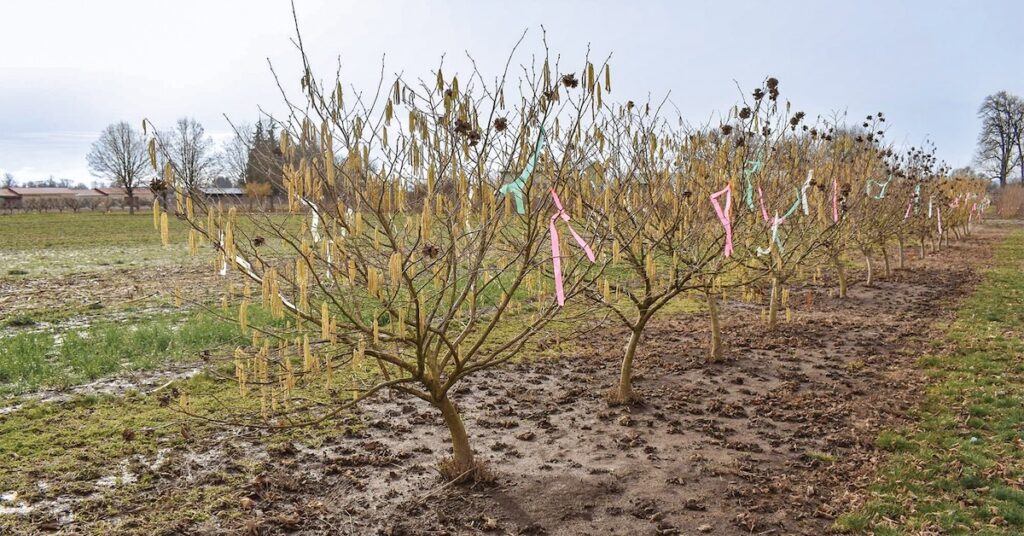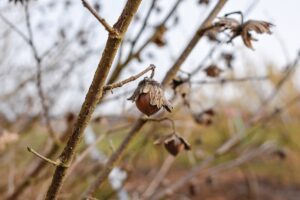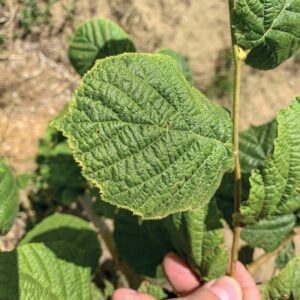
July/August 2025
2,4-D drift delays kernel drop in hazelnut
Hazelnut growers in the Willamette Valley have been telling us what research now confirms: The herbicide 2,4-D drifting into the tree canopy delays nut drop (abscission) in hazelnut orchards. In this article, you will learn the sources of 2,4-D drift, the environmental conditions that support it and how to reduce the risk of 2,4-D drift in your orchard. Grower observation inspired this field research.
Herbicide 2,4-D is a synthetic auxin — a class of growth regulators. It is commonly applied to the base of hazelnut trees to manage suckers. As an herbicide, 2,4-D kills plants by causing xylem cells to grow out of control, disrupting their function.
Sucker management is an essential part of hazelnut production. It facilitates mechanical harvest, removes a potential source of disease organisms and increases yield.
2,4-D is a commonly used herbicide in many production systems in the Willamette Valley, the heart of the U.S. hazelnut industry. Hazelnut orchards are at risk of exposure to 2,4-D drift.
Studies by other researchers in grape, pear and apple indicate delayed fruit ripening after exposure to auxin herbicides.
Sources of drift

Hazelnut orchards may be exposed to damaging 2,4-D drift from applications within the orchard or from 2,4-D drifting in from surrounding crops. Drift can be primary — off-target spray particles at the time of application. Or, it can be secondary — herbicide movement after completion of an application. Volatilization is a common example of secondary drift.
We studied the effect of simulated 2,4-D drift on hazelnut abscission and yield in a 10-year-old hazelnut orchard. Weed and sucker management in the study orchard were consistent with grower standard practice.
Four basal-directed treatments spaced 28 days apart were applied to suckers between May and August during each year of the three-year study. The number and timing of applications were based on the use pattern permitted on the 2,4-D label and adopted by growers. Application rates represented 1-, 2- and 4-fold the maximum seasonal use of 2,4-D.
In a subset of treatments, 2,4-D drift at 1/10th and 1/100th of the field rate was simulated once yearly in the second half of July when nut filling occurs rapidly. Simulated drift was included in years one and two of the study, but not in year three, to evaluate plant recovery from drift in the following season.
Abscission delay

In mild cases, 2,4-D drift in hazelnuts caused symptoms such as leaf cupping, crinkling and chlorosis of leaf margins.
Severe cases of 2,4-D drift resulted in tissue necrosis and dead limbs. Dead limbs were only observed with 2,4-D drift at 1/10th of the field rate (0.6 mg L⁻¹).
Simulated 2,4-D drift delayed hazelnut abscission but only during the years when drift occurred. No lingering effects on hazelnut abscission were observed in subsequent years.
In year one, the time to reach 50% nut fall increased by approximately five days and 15 days for the two drift dosages, respectively. A similar response occurred in year two, with 2,4-D drift delaying nut fall by approximately five and eight additional days.
When 2,4-D was applied directly to suckers (no drift), hazelnut abscission was unaffected, regardless of the rate used (1 to 4 times the annual rate).
Yield
Simulated drift treatments had no effect on yield in year one of the study.
In year two, 2,4-D drift reduced yield by 18% and 37% for drift rates of 1/100th (0.06 mg L⁻¹) and 1/10th (0.6 mg L⁻¹) of the field rate, respectively, compared to the nontreated control.
No impact on maximum yield was observed in year three, which did not receive simulated drift treatments.
Drift reduction practices are essential for ensuring timely hazelnut abscission and maintaining high crop yields.
Mitigating 2,4-D drift in your orchard
Management practices
- Increase droplet size. Use drift reduction nozzles, such as air induction under leaf (AIUB) spray nozzles, to produce larger droplets that are less likely to drift off-target.
- Reduce spray pressure. Lowering spray pressure minimizes the formation of fine droplets, which can remain airborne near the crop and drift into the canopy.
- Monitor wind speed. Avoid spraying during calm conditions, which are often associated with temperature inversions that promote drift into the canopy. Similarly, do not spray when winds exceed 6 mph, as high wind speeds increase the risk of drift.
Environmental conditions
- 2,4-D volatilization is influenced by air temperature and humidity. It can volatilize at temperatures above 60°F, with the likelihood increasing significantly above 85°F, especially when humidity is low.
- Spray drift moves most efficiently at wind speeds greater than 6 mph.
Reducing the risk of 2,4-D drift in orchards
- Spray herbicides or agricultural products when wind speeds measure between 2 and 8 mph.
- Equip sprayers with drift-reduction nozzles, such as turbo air-induction nozzles, to minimize drift.
- Apply 2,4-D at lower pressures to create larger droplets and mitigate the risk of drift.
- Time applications earlier in the season, using 2,4-D before May 30, when air temperatures are lower and less conducive to volatilization.
- Apply 2,4-D during daylight hours to increase weed uptake and reduce the risk of thermal inversion, which is more common in the early morning or evening.
- Choose low-volatility 2,4-D formulations, such as acid or choline formulations, to reduce drift risk.
- Mild 2,4-D drift symptoms include chlorotic leaf margins, leaf cupping, and crinkling. Severe drift can cause tissue necrosis and dead limbs. A single drift at 1/100th of the field rate delayed hazelnut abscission, and exposure closer to harvest could cause greater delays.
- Consider alternative herbicides if drift is a concern.
- Always follow pesticide label instructions. It is a violation of federal law to apply any herbicide inconsistently with its labeling.
For a list of registered options for sucker control in hazelnuts, refer to Oregon State University’s Pacific Northwest Weed Management Handbook.









